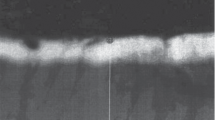Abstract
The possibility of the formation of structures such as compounds of elements between chalcogenides and the transition group of metals in the crystal lattice of silicon is studied. This is an urgent problem in electronics. It is shown that, under certain technological conditions, a sufficient concentration of unit cells is formed, which leads to a change in the band structure of silicon itself; i.e., a micro- and nanoscale inclusion in silicon with a direct-gap structure is obtained. The possibilities of creating a fundamentally new class of photocells with an extended spectral sensitivity region, as well as light-emitting devices, light-emitting diodes, and lasers based on them, are shown.





Similar content being viewed by others
REFERENCES
Saidov, A.S, Usmonov, Sh.N., Kalanov, M.U., and Amonov, K.A., Growth of (Si2)1 – x(ZnSe)x (0 ≤ x ≤ 0.01) solid solution films and investigation of their structural and photoelectric properties, Al’tern. Energ. Ekol., 2013, no. 15 (137), p. 41.
Bakhadyrkhanov, M.K. and Abdurakhmanov, B.A., Physical and technological foundations for the formation of clusters of impurity atoms in silicon, Dokl. Akad. Nauk Resp. Uzb., 2013, no. 3, p. 29.
Saidov, A.S., Razzakov, A., Risaeva, V., and Koshchanov, E., Liquid-phase epitaxy of solid solutions (Ge2)1 – x(ZnSe)x , Miner. Chem. Phys., 2001, vol. 68, p. 1.
Saidov, A.S., Usmonov, Sh.N., Kholikov, K.T., and Saparov, D., Synthesis and characterization of (Si2)1 − x − y(Ge2)x(GaAs)y continuous solid solutions, Tech. Phys. Lett., 2007, vol. 33, p. 701.
Usmonov, Sh.N., Saidov, A.S., Leyderman, A.Yu., Saparov, D., et al., Possibility of obtaining the (GaSb)1 − x(Si2)x films on silicon substrates by the method of liquid-phase epitaxy, Semiconductors, 2009, vol. 43, no. 8, p. 1092.
Saidov, M.S., Silicon solid solutions and the possibilities of their application in cascade solar cells, Geliotekhnika, 1997, nos. 5–6, p. 57.
Coleman, P.D., Freeman. J., Morkoҫ, H., Hess, K., et al., Demonstration of a new oscillator based on real space transfer in heterojuctions, Appl. Phys. Lett., 1982, vol. 40, no. 6, p. 493.
Saidov, A.S., Koshchanov, E.A., and Razzakov, A.Sh., The possibility of improving the structural perfection of the new heterojunctions GaAs–(Ge2)1–x(ZnSe)x, Ge–(Ge2)1 – x(ZnSe)x, GaP–(Ge2)1 – x(ZnSe)x, and Si–(Ge2)1 – x(ZnSe)x , Tech. Phys. Lett., 1998, vol. 24, no. 2, p. 47.
Tursunov, O.B., Fundamental management (E g, µ band structure) silicon is a new direction in the field of semiconductor materials, Eur. Sci. Rev., 2022, nos. 3–4, p. 37.
Mikhailov, A.I. and Mitin, A.V., Experimental investigation of current oscillations spectrum in long high-resistivity planar-epitaxial gallium arsenide structures under light action, Fizika Volnovykh Protsessov i Radiotekhnicheskie Sistemy, 2011, vol. 14, no. 4, p. 87.
Gavrilenko, V.I., Grekhov, A.M., Korbutyak, D.V., and Litovchenko, V.G., Opticheskie svoistva poluprovodnikov: spravochnik (Optical Properties of Semiconductors: A Handbook), Kiev: Naukova dumka, 1987.
Morozova, N.K., Kuznetsov, V.A., Ryzhikov, V.D., Galstyan, V.G., et al., Selenid tsinka. Poluchenie i opticheskie svoistva (Zinc Selenide. Preparation and Optical Properties), Moscow: Nauka, 1992.
Korepanov, V.I, Impul’snyi lyuminestsentnyi analiz (Pulsed Luminescent Analysis), Tomsk: Izd. Tomsk. Politekh. Univ., 2008.
Morozova, N.K. and Mideros, D.A., Effect of Te on the self-activated emission of ZnSe, Semiconductors, 2008, vol. 42, p. 1499.
Morozova, N.K., Mideros, D.A., Gavrishchuk, E.M., and Galstyan, V.G., Role of background O and Cu impurities in the optics of ZnSe crystals in the context of the band anticrossing model, Semiconductors, 2008, vol. 42, p. 131.
Fedorov, V.V., Mirov, S.B., Gallian, A., Badikov, D.V., et al., 3.77–5.05-μm Tunable solid-state lasers based on Fe2+-doped ZnSe crystals operating at low and room temperatures, IEEE J. Quant. Electron., 2006, vol. 42, no. 9, p. 907.
Sorokina, I.T., Sorokin, E., Mirov, S.B., Fedorov, V.V., et al., Opt. Lett., 2002, vol. 27, p. 1040.
Bakhadyrkhanov, M.K., Isamov, S.B., Iliev, Kh.M., Tachilin, S.A., et al., Silicon-based photocells of enhanced spectral sensitivity with nano-sized graded band gap structures, Appl. Sol. Energy, 2014, vol. 50, p. 61.
Bakhadyrkhanov, M.K., Zikrillaev, N.F., Isamov, S.B., and Koveshnikov, S.V., Fotoelektricheskie yavleniya v kremnii s mnogozaryadnymi nanoklasterami (Photovoltaic Phenomena in Silicon with Multiply Charged Nanoclusters), LAP LAMBERT Academic Publishing, 2019.
Bakhadyrkhanov, M.K., Zikrillaev, N.F., and Ayupov, K.S., Optimal doping conditions for obtaining silicon with intrinsic conductivity, Pribory. Tekhnologiya, Oborudovanie i Novye Materialy, 2018, no. 11 (221), p. 40.
Bakhadyrkhanov M. K., Isamov S.B., IR photodetectors operating under background illumination, Tech. Phys., 2016, vol. 61, p. 458.
Bakhadyrkhanov, M.K., Iliev, Kh.M., Mavlonov, G.Kh., Mamadzhanov Kh., et al., Features of electrical and photoelectric properties of silicon with multicharged clusters of impurity atoms, Tezisy dokladov 2-i mezhd. nauchn. konf. “Fizika i fizicheskoe obrazovanie” (Abstracts of the 2nd Int. Sci. Conf. “Physics and Physical Education”), Bishkek, 2008, p. 33.
Kazanskii, A.G., Mell, H., Terukov, E.I., and Forsh, P.A., Effect of temperature on photoconductivity and its decay in microcrystalline silicon, Semiconductors, 2001, vol. 35, no. 8, p. 953.
Trumbore, F.A., Solid solubilities of impurity elements in germanium and silicon, Bell Syst. Tech. J., 1960, vol. 39, p. 205.
Borisenko, V.E. and Yudin, S.G., Steady-state solubility of substitutional impurities in silicon, Phys. Status Solidi A, 1987, vol. 101, p. 123.
Author information
Authors and Affiliations
Corresponding authors
Ethics declarations
The authors declare that they have no conflict of interest.
About this article
Cite this article
Zikrillaev, N.F., Tursunov, O.B. & Kushiev, G.A. Development and Creation of a New Class of Graded-Gap Structures Based on Silicon with the Participation of Zn and Se Atoms. Surf. Engin. Appl.Electrochem. 59, 670–673 (2023). https://doi.org/10.3103/S1068375523050198
Received:
Revised:
Accepted:
Published:
Issue Date:
DOI: https://doi.org/10.3103/S1068375523050198



